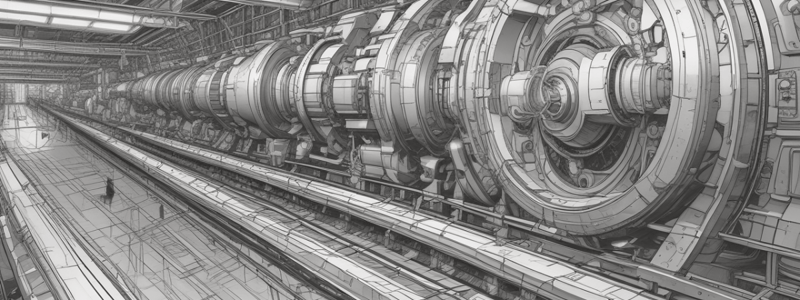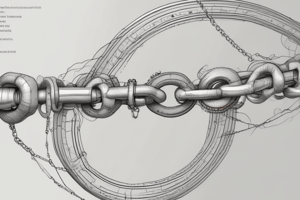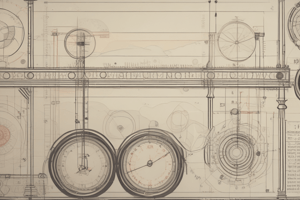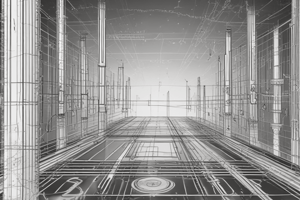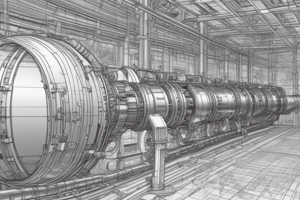Podcast
Questions and Answers
What is the primary factor that affects the measuring accuracy of line-graduated instruments?
What is the primary factor that affects the measuring accuracy of line-graduated instruments?
- The material used to make the instrument
- The skill of the user
- The original accuracy of the line graduations (correct)
- The quality of the attachments
Why is it essential to compensate against wear in instruments that have a scale?
Why is it essential to compensate against wear in instruments that have a scale?
- To increase the accuracy of measurements
- To reduce the cost of the instrument
- To improve the user's skill
- To prevent the instrument from becoming a suspect (correct)
What is the main advantage of using attachments with linear measurement instruments?
What is the main advantage of using attachments with linear measurement instruments?
- They reduce the cost of the instrument
- They increase the accuracy of measurements
- They enhance the versatility of instruments (correct)
- They simplify the operation of the instrument
Why is proper training essential for the user of linear measurement instruments?
Why is proper training essential for the user of linear measurement instruments?
What is the fundamental principle that ensures accuracy and reliability of measurements in linear measurement instruments?
What is the fundamental principle that ensures accuracy and reliability of measurements in linear measurement instruments?
What is the advantage of dial versions of linear measurement instruments?
What is the advantage of dial versions of linear measurement instruments?
What contributes to accumulated error in linear measurement instruments?
What contributes to accumulated error in linear measurement instruments?
What is the ultimate factor that ensures accuracy in linear measurement instruments?
What is the ultimate factor that ensures accuracy in linear measurement instruments?
What is the primary purpose of thread measurement in manufacturing and engineering?
What is the primary purpose of thread measurement in manufacturing and engineering?
What is the largest diameter of an external or internal thread?
What is the largest diameter of an external or internal thread?
Which of the following thread fits requires force for assembly, leading to a tight fit?
Which of the following thread fits requires force for assembly, leading to a tight fit?
What is the name of the international standard for thread tolerances?
What is the name of the international standard for thread tolerances?
Which gauging method measures the pitch diameter of the thread with high precision?
Which gauging method measures the pitch diameter of the thread with high precision?
Why is it essential to measure threads in a controlled environment?
Why is it essential to measure threads in a controlled environment?
What is the purpose of regularly calibrating and inspecting measuring tools?
What is the purpose of regularly calibrating and inspecting measuring tools?
Which type of gauge must fit the thread during gauging?
Which type of gauge must fit the thread during gauging?
What is a major advantage of electronic instruments over mechanical instruments?
What is a major advantage of electronic instruments over mechanical instruments?
Why is a micrometer more reliable than a vernier scale?
Why is a micrometer more reliable than a vernier scale?
What is the purpose of a ratchet stop in a measuring instrument?
What is the purpose of a ratchet stop in a measuring instrument?
What is a major requirement of a comparator?
What is a major requirement of a comparator?
What is the advantage of comparison measurement over direct measurement?
What is the advantage of comparison measurement over direct measurement?
What is the purpose of amplification in a comparator?
What is the purpose of amplification in a comparator?
What is resolution in the context of a comparator?
What is resolution in the context of a comparator?
Why is it necessary to strike a compromise between amplification and the ability to sense small changes in the input signal in a comparator?
Why is it necessary to strike a compromise between amplification and the ability to sense small changes in the input signal in a comparator?
What is the primary factor that influences readability in comparators?
What is the primary factor that influences readability in comparators?
What is the primary purpose of incorporating a provision to compensate for temperature effects in comparators?
What is the primary purpose of incorporating a provision to compensate for temperature effects in comparators?
What is the classification of comparators based on the means used for comparison?
What is the classification of comparators based on the means used for comparison?
What is the primary advantage of mechanical comparators?
What is the primary advantage of mechanical comparators?
What is the primary function of a dial indicator in metrology?
What is the primary function of a dial indicator in metrology?
What is the typical least count of a dial indicator?
What is the typical least count of a dial indicator?
What is the purpose of the bezel clamp in a dial indicator?
What is the purpose of the bezel clamp in a dial indicator?
What is the primary difference between continuous and balanced dials in a dial indicator?
What is the primary difference between continuous and balanced dials in a dial indicator?
What is the primary function of a comparator?
What is the primary function of a comparator?
What is the main advantage of electrical comparators over mechanical comparators?
What is the main advantage of electrical comparators over mechanical comparators?
How does an electrical comparator achieve magnification?
How does an electrical comparator achieve magnification?
What is the function of the plunger in an electrical comparator?
What is the function of the plunger in an electrical comparator?
What is the principle behind pneumatic comparators?
What is the principle behind pneumatic comparators?
What is an advantage of pneumatic comparators over mechanical comparators?
What is an advantage of pneumatic comparators over mechanical comparators?
What is the range of measurement possible with pneumatic comparators?
What is the range of measurement possible with pneumatic comparators?
What is the purpose of amplification in comparators?
What is the purpose of amplification in comparators?
Flashcards are hidden until you start studying
Study Notes
Linear Measurement Instruments
- Designed to meet high demands of accuracy and precision, while being simple to operate and cost-effective
- Important considerations for design:
- Measuring accuracy depends on the original accuracy of line graduations
- Instruments with scales require compensation against wear
- Attachments can enhance versatility but also contribute to accumulated error
- User skill is essential for accurate measurements
- Principle of alignment: line of measurement and line of dimension being measured should be coincident
- Electronic versions provide convenience, but basic principles must be adhered to
- Readability is crucial, and instruments with better readability are more reliable
- Digital instruments offer ease of signal processing and direct expression of readings in required form
Comparators
- Must provide high accuracy and precision, convenience, and withstand rough operating environments
- Major requirements:
- High accuracy and precision
- Linear scale with a wide range
- High amplification
- Good resolution
- Provision for temperature compensation
- Versatility with attachments and flexible means
- Classification of comparators:
- Mechanical comparators
- Mechanical-optical comparators
- Electrical and electronic comparators
- Pneumatic comparators
- Other types (projection, multi-check)
Mechanical Comparators
- Provide simple and cost-effective solutions
- Skills for fabrication and use can be learned relatively easily
- Important comparators in metrology:
- Dial Indicator: used to compare workpieces against a master, with interchangeable contact points and a scale that provides the required least count
Electrical Comparators
- Use electrical signals for measurement
- Main elements:
- Plunger (sensing element)
- Armature
- Coils
- Output display device
- Can achieve high magnification (up to 10^5:1)
Pneumatic Comparators
- Use air as a means of measurement
- Basic principle: changes in calibrated flow respond to changes in part feature
- Advantages:
- Absence of metal-to-metal contact
- Higher amplification
- Low cost
- Can be used for inspecting multiple dimensions of a part in a single setting
Thread Measurement
- Screw thread limits define the acceptable range of thread dimensions
- Key parameters:
- Major Diameter
- Minor Diameter
- Pitch Diameter
- Lead
- Pitch
- Fit limits determine how tightly or loosely the threaded parts will fit together
- Tolerance classes:
- Unified Thread Standard (UTS)
- ISO Metric Thread
- Gauging methods:
- Go/No-Go Gauges
- Thread Micrometers
- Optical Comparators
- Coordinate Measuring Machines (CMM)
Studying That Suits You
Use AI to generate personalized quizzes and flashcards to suit your learning preferences.
